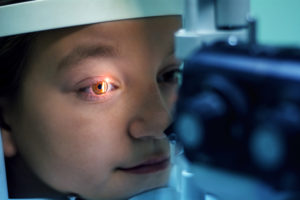January 3, 2022
By Dwight Akerman, OD, MBA, FAAO, FBCLA, FIACLE

This investigation aimed to assess the efficacy and safety of repeated low-level red-light (RLRL) therapy for myopia control in children. The researchers conducted a 12-month, multicenter, randomized, parallel-group, single-blind clinical trial to assess the efficacy and safety of the RLRL therapy for myopia control at five study centers from four tertiary hospitals in China.
In the past decade, increased time spent outdoors in bright light has proven an effective protective factor for myopia development. As an alternative to increasing bright light exposure, the authors proposed to deliver light on the retina directly at a much shorter duration of exposure, but repeatedly for myopia control. They deployed a device that emits red light at 650 nm in wavelength based on the fact that it has already been approved and widely used for amblyopia treatment in China so that the safety of the participants can be potentially maximized.
A total of 264 children were randomly assigned to the intervention group [RLRL treatment plus single vision spectacle (SVS)] and control group (SVS). The RLRL treatment was provided by a desktop light therapy device that emits red light of 650 nm in wavelength, at an illuminance level of approximately 1600 lux and a power of 0.29 mW for a 4-mm pupil. It was administered at home under the supervision of parents, three minutes per session, twice per day with a minimum interval of four hours, five days per week.
In this 12-month, multicenter randomized clinical trial, RLRL treatment slowed axial elongation by 0.26 mm and SER progression by 0.59D compared with SVS, respectively, representing 69.4% and 76.6% slowing axial elongation and myopic refraction progression.
The researchers concluded that RLRL therapy is a promising alternative treatment for myopia control in children with good user acceptability and no documented functional and structural damages.
Abstract
Effect of Repeated Low-Level Red-Light Therapy in Myopia Control in Children: A Multicenter Randomized Controlled Trial
Yu Jiang, MD, Zhuoting Zhu, MD, PhD, Xingping Tan, MD, Xiangbin Kong, MD, PhD, Hui Zhong, PhD, Jian Zhang, MD, Ruilin Xiong, MD, Yixiong Yuan, MD, Junwen Zeng, MD PhD, Ian G. Morgan, PhD, Mingguang He, MD, PhD
Purpose: To assess the efficacy and safety of repeated low-level red-light (RLRL) therapy in myopia control in children.
Design: Multicenter, randomized, parallel-group, single-blind clinical trial.
Participants: A total of 264 eligible children aged 8 to 13 years with myopia of cycloplegic spherical equivalent refraction (SER) of -1.00 to -5.00D, astigmatism < 2.50D, anisometropia < 1.50D, best-corrected visual acuity (BCVA) >0.0 logMAR (Snellen 1.0 or 20/20) were enrolled in July to August 2019. Follow-up was completed in September 2020.
Methods: Children were randomly assigned to the intervention group [RLRL treatment plus single vision spectacle (SVS)] and control group (SVS). The RLRL treatment was provided by a desktop light therapy device that emits red light of 650 nm in wavelength, at an illuminance level of approximately 1600 lux and a power of 0.29 mW for a 4-mm pupil (Class I Classification), and was administered at home under supervision of parents, 3 minutes per session, twice per day with a minimum interval of 4-hours, five days per week.
Main outcome measures: The primary outcome and a key secondary outcome were changes in axial length (AL) and SER measured at baseline, and 1-, 3-, 6- and 12-month follow-up visits. Participants who had at least one post-randomization follow-up visit were analyzed for treatment efficacy based on a longitudinal mixed model.
Results: Among 264 randomized participants, 246 (93.2%) children were included in the analysis (n = 117 in the RLRL and n = 129 in the SVS group). Adjusted 12-month axial elongation and SER progression were 0.13 mm (95% CI: 0.09 to 0.17) and -0.20 D (95% CI: -0.29 to -0.11) for RLRL treatment, 0.38 mm (95% CI: 0.34 to 0.42) and -0.79 D (95%CI, -0.88 to -0.69) for SVS. The difference in axial elongation and SER progression were 0.26 mm (95% CI: 0.20 to 0.31) and -0.59D (95% CI: -0.72 to -0.46) between the RLRL and SVS groups. No severe adverse events (sudden vision loss by 2 lines or scotoma developed), functional visual loss indicated by BCVA, or structural damage seen on optical coherence tomography scans were observed.
Conclusions: RLRL therapy is a promising alternative treatment for myopia control in children with good user acceptability and no documented functional and structural damages.
Jiang, Y., Zhu, Z., Tan, X., Kong, X., Zhong, H., Zhang, J., … & He, M. (2021). Effect of Repeated Low-Level Red-Light Therapy in Myopia Control in Children: A Multicenter Randomized Controlled Trial. Ophthalmology.
DOI: https://doi.org/10.1016/j.ophtha.2021.11.023













